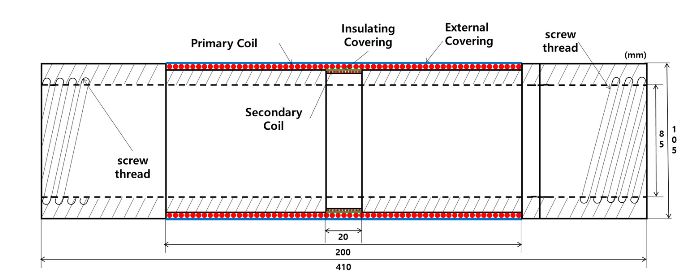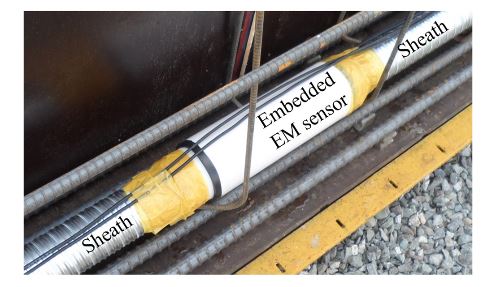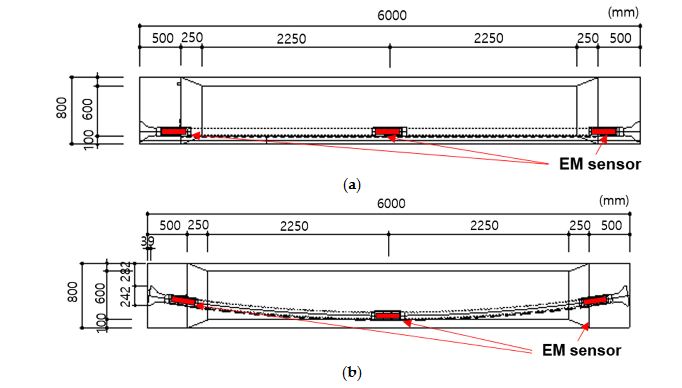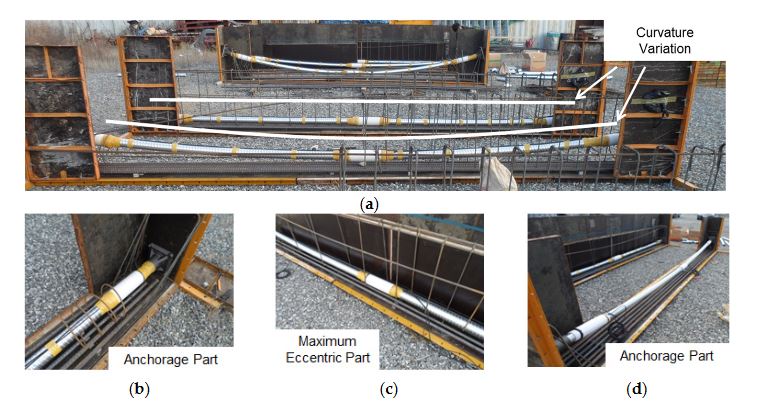ABSTRACT
The tensile force of pre-stressed concrete (PSC) girders is the most important factor for managing the stability of PSC bridges. The tensile force is induced using pre-stressing (PS) tendons of a PSC girder. Because the PS tendons are located inside of the PSC girder, the tensile force cannot be measured after construction using conventional NDT (non-destructive testing) methods.
To monitor the induced tensile force of a PSC girder, an embedded EM (elasto-magnetic) sensor was proposed in this study. The PS tendons are made of carbon steel, a ferromagnetic material. The magnetic properties of the ferromagnetic specimen are changed according to the induced magnetic field, temperature, and induced stress. Thus, the tensile force of PS tendons can be estimated by measuring their magnetic properties. The EM sensor can measure the magnetic properties of ferromagnetic materials in the form of a B(magnetic density)-H (magnetic force) loop.
To measure the B-H loop of a PS tendon in a PSC girder, the EM sensor should be embedded into the PSC girder. The proposed embedded EM sensor can be embedded into a PSC girder as a sheath joint by designing screw threads to connect with the sheath. To confirm the proposed embedded EM sensors, the experimental study was performed using a down-scaled PSC girder model. Two specimens were constructed with embedded EM sensors, and three sensors were installed in each specimen.
The embedded EM sensor could measure the B-H loop of PS tendons even if it was located inside concrete, and the area of the B-H loop was proportionally decreased according to the increase in tensile force. According to the results, the proposed method can be used to estimate the tensile force of unrevealed PS tendons.
DEVELOPMENT OF THE EMBEDDED EM SENSOR

Figure 1. Schematic of the embedded EM sensor
This study applied an EM sensor to estimate the tensile force of PS tendons. The EM sensor can measure the induced stress of ferromagnetic specimen by the elasto-magnetic effect. The EM sensor should be located inside a PSC girder to measure the magnetic responses of the PS tendons because the tendons are built into the PSC girder and could not approach after casting concrete.
To apply an EM sensor to an actual PSC girder, an embedded EM sensor was developed. The embedded EM sensor consists of a cylindrical bobbin with screw threads on both ends to connect with the sheath, a primary coil to generate a magnetic field, a secondary coil to measure the magnetic response of the PS tendon, and an external cover to protect the coils, as shown in Figure 1.

Figure 3. Installation of an embedded EM sensor
Figure 3. Both sides of the EM sensor have screw threads, allowing the sensor to be installed at any Both sides of the EM sensor have screw threads, allowing the sensor to be installed at any position along the sheath line. Also, the joints are sealed using tape to prevent water permeation into the sheath.
EXPERIMENTAL STUDY

Figure 4. Schematic diagram of the test specimens. (a) Specimen 1: Straight sheath; (b) Specimen 2: Curved sheath

Figure 5. Installation of embedded EM sensors in a PSC girder. (a) EM sensor installed PSC girder, (b) Right anchorage part, (c) Maximum eccentric part, (d) Left anchorage part
To confirm the proposed tensile force monitoring method, two down-scaled PSC girder specimens were constructed as shown in Figure 4. The span of the girders was 6 m, and the height was 1 m. The girders had 1 sheath line in each specimen (specimen 1 had a straight sheath, and specimen 2 had a curved sheath), and the embedded EM sensors were installed at the left and right anchorage parts and the maximum eccentric part as shown in Figures 4 and 5.
CONCLUSIONS
An embedded EM sensor based tensile force monitoring for PSC girders was proposed in this research. The B-H loop of ferromagnetic material is affected by the induced tensile force in the specimen. To measure the B-H loop of PS tendons in a PSC girder, an embedded EM sensor was developed as a sheath joint. To validate the proposed method, a down-scaled PSC girder test was performed using two PSC girder specimens that had 1 sheath line in each specimen.
The embedded EM sensors were installed at the left and right anchorage parts and at the maximum eccentric part through the sheath before casting concrete. After casting and curing concrete, tensile force was induced in steps, and the B-H loop was measured at every tensile force step. Also, the reference tensile forces were measured from the load cell at the left anchorage of each specimen. The area of the B-H loop decreased with tensile force increase.
To quantify the area variation, the area ratio was calculated, and the equation for estimating tensile force was derived by comparing the area ratio and reference tensile force. According to the results, the embedded EM sensor can measure the magnetic responses of unrevealed PS tendon even if it located inside of concrete and the tensile force could be estimated based on the area ratio variations of the PS tendon using the embedded EM sensors in the field environment.
Source: Sungkyunkwan University
Authors: Junkyeong Kim | Ju-Won Kim | Chaggil Lee | Seunghee Park